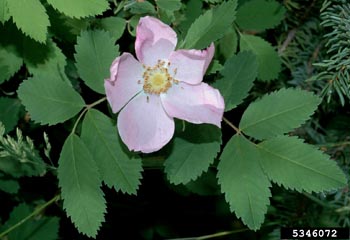Woods Rose

Common Name(s):
Woods Rose
Wild Rose
Scientific Name:
Rosa woodsii Lindl.
Scientific Name Synonyms:
None known
Symbol:
SYOR2
Description:
Life Span: Perennial
Origin: Native
Season: Cool
Growth Characteristics: A 2 to 5 foot tall shrub, usually forming thickets. Growth starts in early spring, flowers May to July, and reproduces from seed, rhizomes, sprouting, and layering.
Flowers/Inflorescence: Flowers found in clusters, with 5 petals, 5 sepals, and many stamens. White to dark rose in color.
Fruits/Seeds: Seeds are contained within an orange-red, round hip, which generally stays on the bush throughout the winter.
Leaves: Alternate leaves, leaflets odd-pinnately compound. Leaflets oval, with toothed (serrate) margins, and upper surface of leaf shiny. Stipules are prominent, united at base.
Stems: Twigs are reddish-brown to gray, with straight or recurved prickles (small thorns). The lower trunk is is red-brown, irregularly split to reveal white inner bark underneath. Buds are red and glossy.
Ecological Adaptions:
Wild rose occurs on prairies, plateaus, dry slopes, and in open woods, ravines, and thickets, growing at elevations from 3500 to 7500 feet. It is a common riparian species. It is fairly tolerant of browsing. It can thrive from moderate shade to full sunlight. Wild rose is very fire tolerant, and usually survives to produce an abundance of sprouts.
Soils: Wild rose is adapted to a wide range of soil types and textures. Growth is generally best on moderately fertile, well-drained clay loam, sandy loam, or sandy soils. It is also adapted to a broad range of moisture conditions but tends to favor moist, well-drained soils that are present in riparian ecosystems. Wood's rose is tolerant of moderately acid to weakly basic soils.
Associated Species: Kentucky bluegrass, redtop, gambel oak, Nevada bluegrass, chokecherry, and coyote willow.
Uses and Management:
Wild rose is browsed by livestock and big game from spring through fall, preferring this shrub in the spring when the leaves appear. Porcupines and beavers also browse the leaves.
Wild rose hips persist on the plant through much of the winter. Many birds and mammals are sustained by these dry fruits when the ground is covered with snow.
It produces extensive rhizomes, and has good survivability and revegetation characteristics even on harsh sites, making this species an effective material for erosion control.
Europeans utilized hips as a source of Vitamins A and C. Rose hip powder was used as a flavoring in soups and for making syrup. American Indians utilized the young shoots as a potherb. The leaves were steeped for tea, petals were eaten raw, in salads, candied, or made into syrup. The inner bark was smoked like tobacco, and dried petals were stored for perfume.

